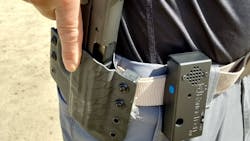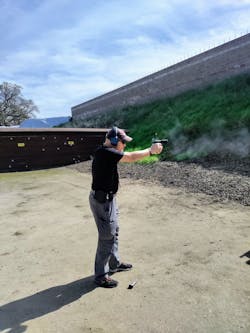The RangeTech Shot Timer: Make it Measurable
Shot timers traditionally are instruments designed to improve practice and record shooting competitions using a shot sensor, which “listens” for gunshots and records the exact time they happen. They register the shots and measure the time between shots, and how long it takes for a shooter to complete a given event. Shot timers normally have features like start beeps, which tell the shooter when to draw and begin firing. They are indispensable when it comes to measuring training effectiveness and improvement.
I had the perfect task for my RangeTech. I got a new holster for my FNP-9, and I needed to insure my presentation was smooth. When I began testing, it identified a couple of training deficiencies about which I am a bit abashed about sharing.
My wife came to the range with me to test this device. Besides the fact that I had to be on my best behavior, we discovered one of the best advantages to the RangeTech Shot Timer. We set it up to communicate with her phone. While she ran the timer from a shady spot on the range, she also was able to take photos of the training. One can attach photos of targets and training directly to the training session. Some of the photos of me are downright silly, and I think she did it deliberately.
The RangeTech Shot Timer differs from conventional shot timers because it doesn’t have a display of its own. It connects via Bluetooth to an Android or an iOS device, using their custom app, allowing a sort of tethered operation. The display on a cell phone is much bigger than the tiny windows on other shot timers. I liked having a lot of information on the screen of my app.
With the RangeTech Shot Timer, the part that delivers the start beep and registers the shots stays with the shooter. The phone is the part that does the recording and it can be up to 75 feet away, depending on the Bluetooth capabilities. In actual practice, we were able to separate the phone and shot timer between 50 to 80 feet without any data transfer problems.
There are several advantages to this tethered method of operation. First, users put shot timers on their belts, so the shot sensor registers each shot. The shot sensor has to be in the proximity of the muzzle in order to get a good reading. If the timer is being used to measure a competitive event, the person doing the timing has to be right next to the shooter, or shots aren’t recorded. They also have to be close enough so the shooter hears the starting beep.
Besides an increase in range safety, it made testing and competition a lot more objective. That is, a competitive shooter can “sense” that the start beep was going to happen, simply by the body activity of the range officer. Even in training, because the shooter and person timing are almost on top of each other, there are unplanned range collisions. A little bit of separation cannot hurt.
My FNP-9 predates the FN 509, a gun with advanced features suitable for duty, both Law Enforcement and Military. It is a DASA, which means the first shot is double action, and subsequent shots are single action. For those who grew up only around striker fired guns, this means the first trigger pull is longer, because it is cocking and releasing the hammer, which fires the gun.
Double action shooting takes longer. Analyzing the time between the start signal and the first shot, compared to follow up shots, should give me some good numbers. If my theory is correct, my double action initial shot from my FNP-9 will be slower than that of my Glock, but follow up shots may be faster. Steady training will even out these numbers.
Since the RangeTech Shot Timer runs off of an app, all of the advantages of using a mobile device come into play. First, it allows the user to save data. For agencies with time standards in their qualification, the records of qualification times and even images of targets and training events can be memorialized and accessed. This type of training recording, if standardized, can respond to a governmental responsibility to adequately train, thus upholding the constitutional rights of the municipal inhabitants (City of Canton, Ohio v. Harris, 489 U.S. 378 - 1989, City of Springfield v. Kibbe, 480 U.S. 257 - 1987).
The timer itself is pretty simple. It has an on/off switch and a dual purpose button. The button starts and stops the timer. If one presses and holds, it stops and audibly announces the raw total time through the phone. It has a speaker whose beep is loud enough to be heard when one is using simple earplugs, rather than the electronic muffs I use.
The box itself is pretty durable, but it’s not completely waterproof. It attaches to the user’s belt using the same type of belt clip as a magazine belt clip. It’s not much larger than a magazine in its holder, so this works well. The instructions tell the user to use the bag in which it came to cover the box in the rain. It is definitely loud enough and sensitive enough to have a bag over it. The sensitivity is adjustable, just in case shooters are using steel, which can give a false reading, or users are shooting in tandem.
It took less than a couple of hours to charge the unit, and it gets about 8 hours of use. For the average user, that is several range sessions.
The RangeTech Shot Timer is smaller than most timers that go on the belt, and it is much easier to use. It’s cheaper, by quite a bit, actually. At $74.99, it is sixty bucks cheaper than the most popular timer on the market.
The app is free, and very intuitive. It is available for Android or IOS. Since I have several devices with several operating systems, I tried them all. You should know that the display is so huge on a tablet that one can prop it up on a nearby table behind the range and see it clearly. The app is also easier to see on a cell phone than any of the tiny display timers on the market today. As you might have guessed, I like using the app better than I like pressing the buttons on competitive timer brands.
The other advantage of having an app is being able to have seamless updating and the potential for easy firmware updates.
How does one use a shot timer to its fullest? First, there are plenty of drills that will work, and most of them have a time standard, or they can be timed. When I am trying to learn equipment, I use the One and One Drill (“Three Firearm Training Drills Made Easy,” Law Enforcement Technology, April/May 2020). I run this drill smoothly, recording the time. This, by the way, is exactly what I used to test the RangeTech Timer. When I establish a par, I attempt to improve on the time. I work on smoothness first, then try to inject speed.
I did improve shooting with my FNP-9, and the RangeTech Shot Timer was one of the reasons. For a law enforcement training product, the RangeTech Shot Timer has tremendous training value. To my knowledge, this is the least expensive shot timer on the market today. Despite the price, it turned out to be the most feature-rich product in this category.
RangeTech is a small business and their Shot Timer is made right here in the United States.

Officer Lindsey Bertomen (ret.), Contributing Editor
Lindsey Bertomen is a retired police officer and retired military small arms trainer. He teaches criminal justice at Hartnell College in Salinas, California, where serves as a POST administrator and firearms instructor. He also teaches civilian firearms classes, enjoys fly fishing, martial arts, and mountain biking. His articles have appeared in print and online for over two decades.




